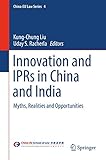China-EU Law Series. Volume 4.
Material type: TextPublication details: Singapore: Springer, 2016.Description: xi, 224pISBN:
TextPublication details: Singapore: Springer, 2016.Description: xi, 224pISBN: - 978-981-10-0405-6
- Part I. Doctrinal and Empirical Analysis Introduction: China and India as contrast Pair in Innovation and IP Do IPRs Promote Innovation? Technology and Business Innovation: Role and Value Measurement of IPRs Does Patent Strategy Shape the Long-Run Supply of Public
- PART II. Study on India Innovation, IP and India: The Dichotomy Between Facts and Fiction The Law and Politics of Pharmaceutical Patents in India
- Part III. Study on China IPRs in China-Market-Oriented Innovation of Policy-Induced Rent-Seeking Estimates of the Value of Patent Rights in China Patent-Information Based Study on Patenting Behavior in China
- 347.77:330 LIU
| Item type | Current library | Call number | Status | Date due | Barcode |
|---|---|---|---|---|---|
|
|
IUCIPRS General Stacks | 347.77:330 LIU (Browse shelf(Opens below)) | Available | IPR4384 |
Browsing IUCIPRS shelves, Shelving location: General Stacks Close shelf browser (Hides shelf browser)

|

|

|

|

|

|

|
||
| 347.77:33 TOW.3 The economics of intellectual property | 347.77:33 TOW.4 The economics of intellectual property | 347.77:330 HAL Intellectual Property and the New International Economic Order: oligopoly, regulation and wealth redistribution in the global knowledge economy | 347.77:330 LIU China-EU Law Series. Volume 4. | 347.77:330.831.8 MCI Property rights and neoliberalism : cultural demands and legal actions | 347.77:338.439.02 JAN Intellectual property law of plants | 347.77:338.439.02 LAW The intellectual property and food project : from rewarding innovation and creation to feeding the world |
This book examines the two most populous nations-India and China-in an effort to demystify the interaction between intellectual property rights(IPR) regimes, innovation and economic growth by critically looking at the economic and legal realities. In addition, it analyzes the question of how innovation can best be transformed into IPR, and how IPR can best be exploited to encourage innovation. Comparing and contrasting these two fastest-growing economics in the last three decades, and together their populations make up one third of the world's total population: as such, exploring how to sustain their growth via innovation and commercialization of IPR could have a tremendous positive impact on global well-being.


There are no comments on this title.